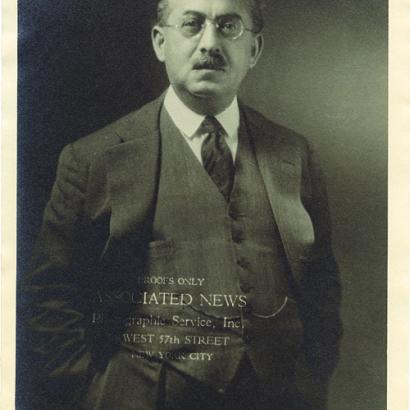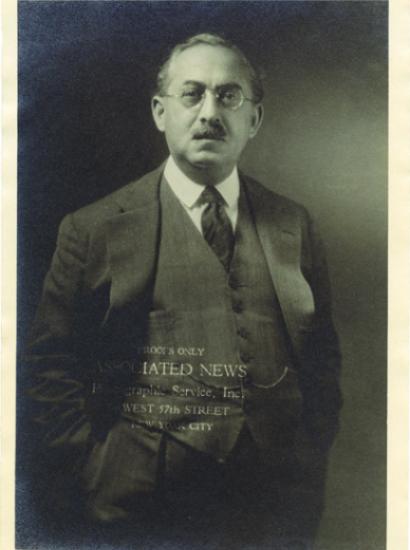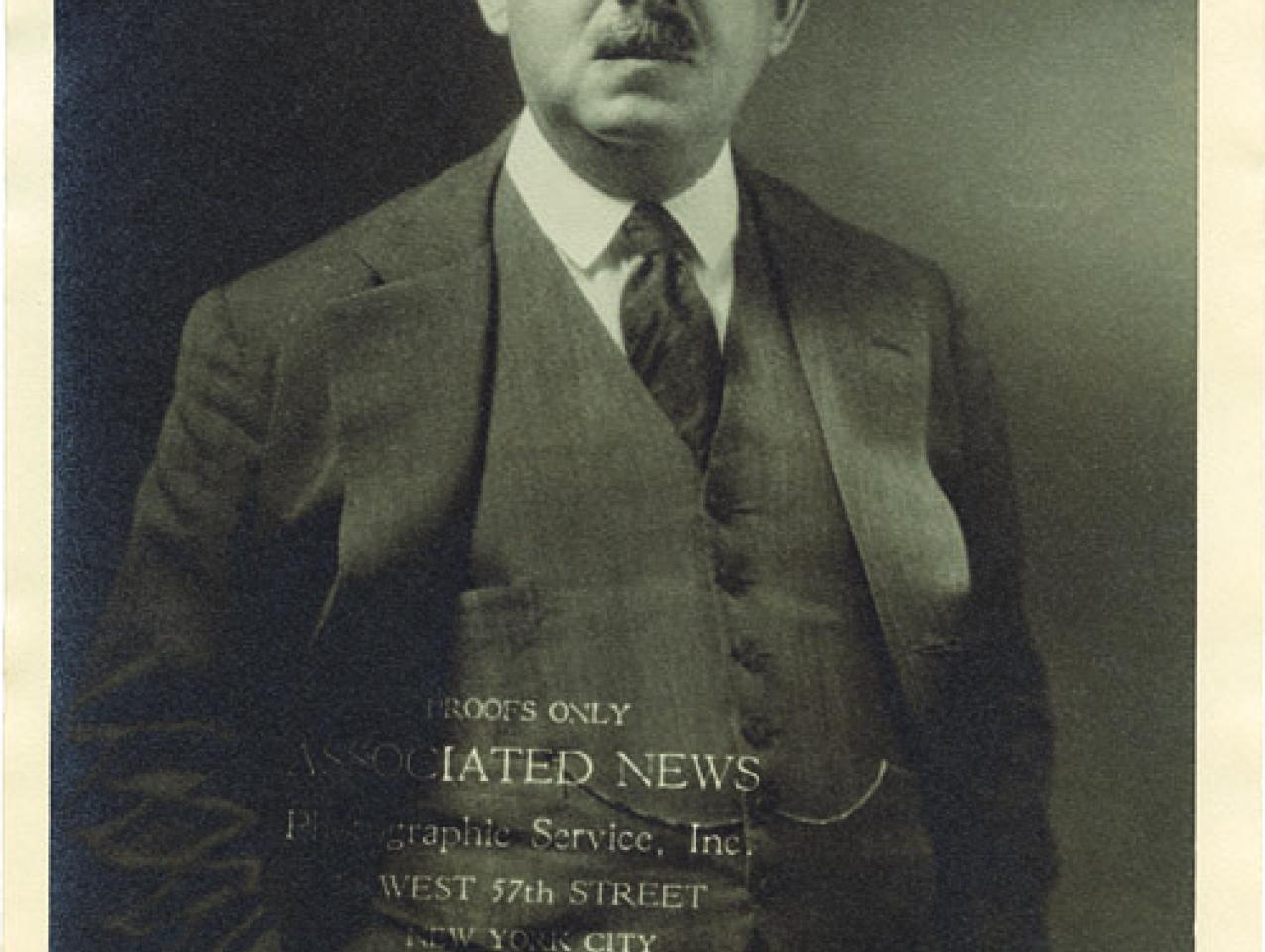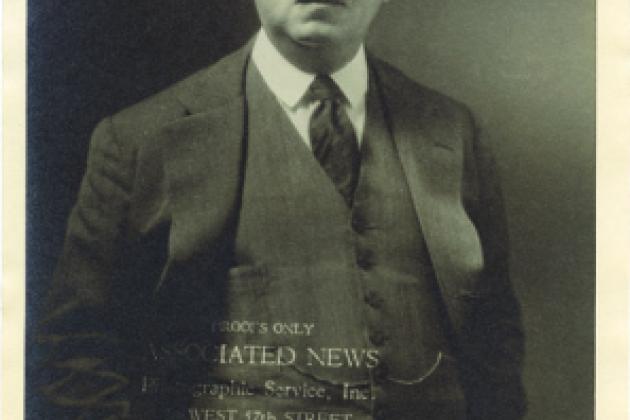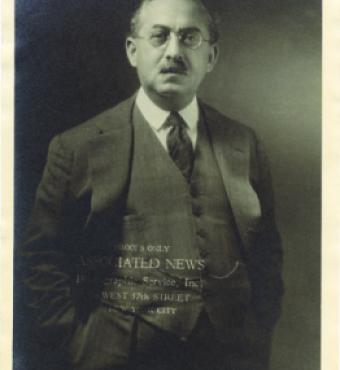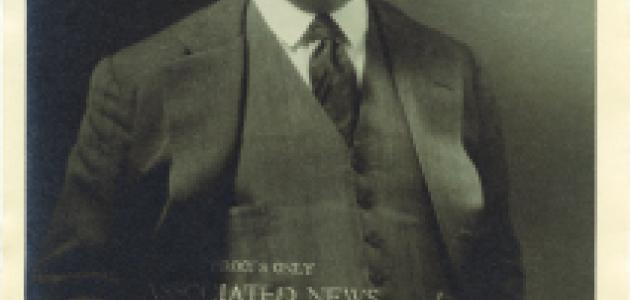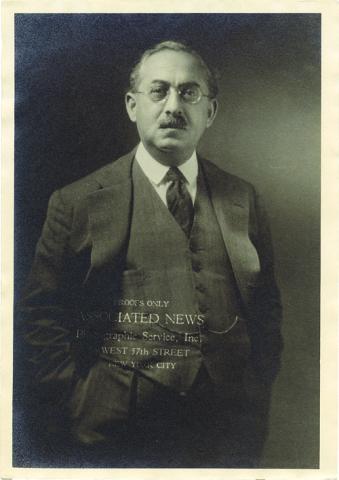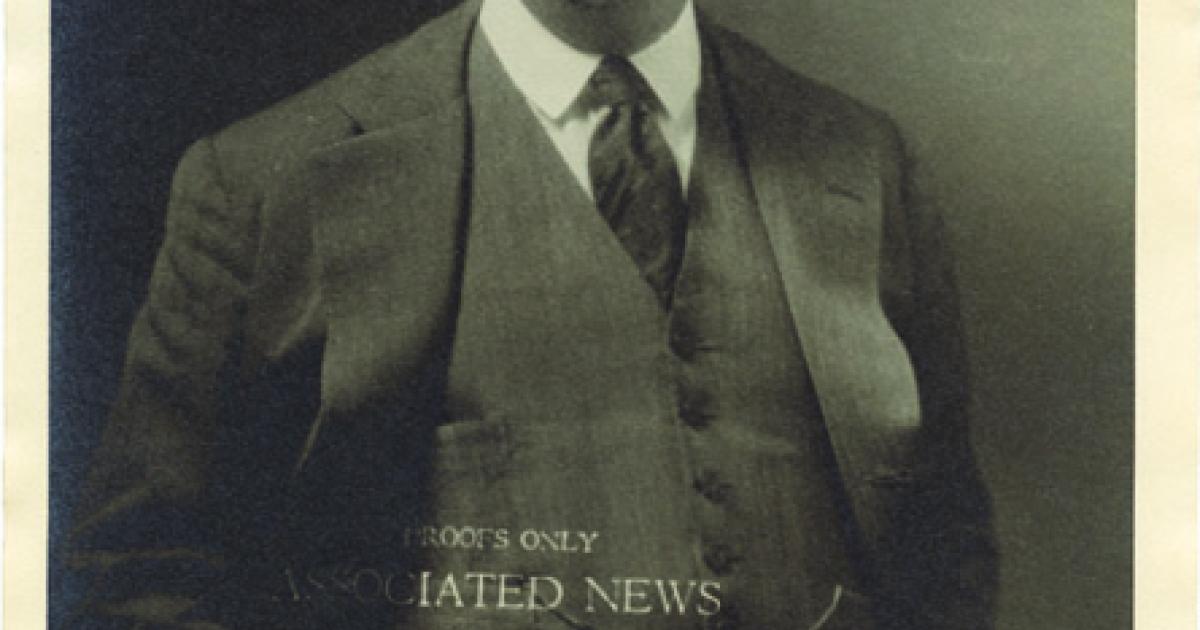- Education
- Politics, Institutions, and Public Opinion
- Law & Policy
- Civil Rights & Race
Does this quotation from the New York Times sound familiar? It should. Reports that the United States is falling behind many countries in technological fields have become commonplace. In response to such claims, President Obama announced in 2011 a program to train ten thousand new American engineers every year and generally promote education in science, technology, engineering, and mathematics. The clear emphasis is that although weapons and soldiers are the front line of national defense, a modern nation ultimately depends for its security on the intellectual preparation of its citizens.
Yet the quotation is not recent; it appeared in the Times more than a half-century ago, on June 19, 1955. Over the decades since then, U.S. policy makers, like the president, have often despaired of the failure of American education to keep pace in science and math in view of the seeming superiority of other nations in these areas. In doing so, these policy makers often gloss over the fact that evidence about shortages of scientists and engineers has been inconclusive.
Consider the consequences of extrapolating beyond the evidence. As the New York Times article claims, the condition and focus of education are matters of national security and economic well-being. If it is true that the United States falls short in preparing scientists and engineers, national security is indeed at risk. If it is not true, however, then precious national resources will be wasted trying to fill a gap that does not exist.
Where do we turn for reliable evidence to answer such issues of vital national concern? The area of research that most focuses on how schooling affects national security, economic development, wars, revolutions, and peace is comparative education, a field that applies the theories and methods of history and the social sciences to understanding international issues of education. Though having strong roots in the nineteenth century, comparative education grew up in the twentieth, guided in good measure by two of the field’s giants: Isaac L. Kandel (1881–1965) and William W. Brickman (1913–1986). The Hoover Institution Archives houses the main collections of documents from both of these influential scholars.
SCHOLARS OF THE WORLD
Kandel and Brickman had much in common. Both were historians, identified strongly as Jews, and generated ideas on education that were shaped by firsthand experiences with international conflict, revolution, and discrimination. As prolific scholars, they advanced many of comparative education’s most important topics: how schools indoctrinate children, build national identities, strengthen or weaken democracy, and reduce or exacerbate ethnic and racial cleavages and gender and social class inequalities.
Kandel was born in Romania and immigrated with his parents to Britain when he was five years old. He was raised in a comfortable but not affluent home and educated in English schools. Brickman, by contrast, was born in the United States to poor immigrant parents; like Kandel, he would live and work in several countries. Both were multilingual, lecturing and writing in several languages as well as English, and both were editors of the highly regarded scholarly periodical School and Society, with Brickman, the younger of the two, following Kandel in that position.
No one gave shape to early twentieth-century scholarship in comparative education more than Isaac Kandel, and no one gave rise to comparative education as a professional field more than William Brickman. Kandel wrote the book Comparative Education, published in 1933, which set the stage for the field’s scholarly development in the decades that followed. Brickman, together with Gerald Read of Kent State University, organized the meetings that saw the birth of the field’s first professional association, the Comparative Education Society, in 1956, the first among about forty national and regional comparative education associations currently recognized by the World Council of Comparative Education Societies, and became its first president.
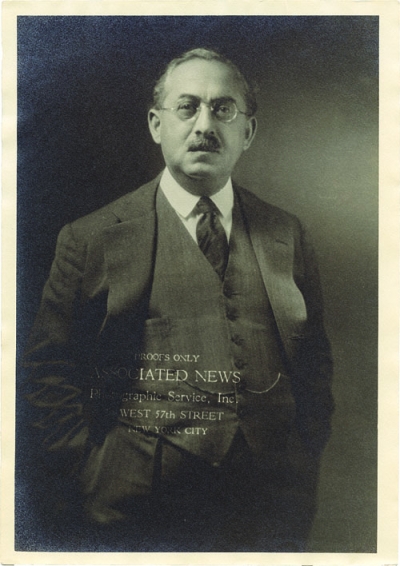
ARISTOCRATIC AIR: The insights of Isaac L. Kandel (1881– 1965) and his younger colleague, William W. Brickman, grew from firsthand experiences with war, revolution, and discrimination. They were intensely interested in how schools build national identities, strengthen or weaken democracy, and affect ethnic, racial, gender, and class inequalities.
Although Kandel and Brickman shared philosophical perspectives, their lifestyles were different. Kandel had a rather aristocratic air and kept a neat and tidy office at Columbia University, as reflected in the impeccably arranged files found in the collection of nine boxes of his papers in the Hoover Archives. By contrast, Brickman’s files in the Hoover Archives are generally loosely and somewhat chaotically organized in 128 boxes, much like the organization of his office at the University of Pennsylvania. Despite their common interests, they engaged in epic philosophical contests that were aligned with the somewhat different periods of time in which they wrote and lectured.
Arguably, their differences in style grew out of their very different upbringings. As a child, Kandel attended an English primary school and then, upon winning a scholarship in a competitive examination, entered the Manchester (England) Grammar School, the largest and one of the oldest (chartered in 1515) independent day school for boys ages seven through eighteen in Britain. The Manchester Grammar School enforced strict discipline, emphasized the classics, and taught students mainly by rote. Kandel studied Latin, Greek, French, and German for six years before entering the University of Manchester to take a degree in classics. Later, he spent a year in Latin America, learned Spanish, and gave a series of lectures in that language in Mexico. He also mastered Portuguese, Dutch, and Norwegian. Though not from an aristocratic family, Kandel had an education that followed classic British upper-class lines.
Brickman grew up in a vastly different environment. His childhood was spent in the impoverished Lower East Side of New York City. His command of languages was an outgrowth of his home environment, where he absorbed Yiddish, Hebrew, Aramaic, Polish, German, and Russian, and his education was molded by the give and take of the Jewish cheder. He eventually learned several other languages—so many, indeed, that in an instruction sheet he handed his students at the University of Pennsylvania he wrote, “A foreign student may present his paper in his native language, but he should first ascertain if the instructor can read it. (As of this date, the instructor does not read Chinese, Japanese, Arabic, Farsi, and the South Asian languages, among others.)” Few American instructors would allow students to write in any language other than English, and if such allowance were made, it would be for no more than one or possibly two foreign languages. How many instructors would specify the languages in which students would not be permitted to write?
Whereas Kandel’s early worldliness was influenced by the international travels of his parents (his father was an exporter), Brickman’s was formed by the stories told by his parents about the old country. His father was born in Germany and his mother grew up in the town of Jedwabne, Poland, and it was there that his parents were married and most of his family lived. However different their backgrounds, as Jews Kandel and Brickman were both deeply affected by the rise of Nazism and the Holocaust.
Kandel was already sixty years old and had lived in New York City for many years when the United States entered World War II in 1941, so he did not have a direct role in the war effort. Brickman, however, was thirty when he was drafted into the U.S. Army in 1943. In view of his command of German, he was recruited by the Office of Strategic Services, the forerunner of the CIA, and his fluency was such that he mastered the dialects of Bavaria, Austria, Silesia, Rhineland, Berlin, and Leipzig. The OSS decided to send him on clandestine missions behind enemy lines.
Brickman’s main task as a spy was to infiltrate the German army to locate high-ranking Nazi officers (like Martin Bormann) who were attempting to flee from the Allied forces as the war was ending. He and several other spies would cross the border into Germany, where high-ranking officers were trying to escape. Brickman would sit at the back of a shop dressed in a Nazi SS uniform as his co-conspirators visited local taverns, where they would let it be known that there was an SS officer capable of arranging escapes to South America. Through this means, Brickman would learn the identity of German officers who wished to escape. Before each of these would-be fugitives came to meet with him, he would place insignia on his uniform indicating he was one rank higher than the visitor. Brickman would then instruct the officer to meet him in the local woods on a certain night, and Brickman’s co-conspirators would sequester the officer and bring him to Nuremberg for interrogation.
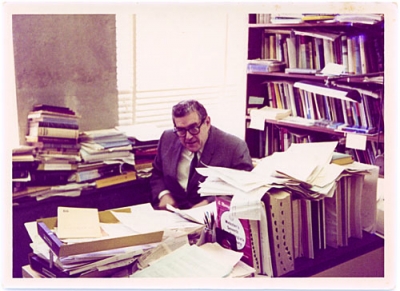
COSMOPOLITAN MIND: William W. Brickman (1913–1986) began learning the first of his many languages as the child of poor immigrants in the Lower East Side. As a professor, he once instructed a class that a student could “present his paper in his native language, but he should first ascertain if the instructor can read it.” Brickman’s office at the University of Pennsylvania, like his boxes of materials in the Hoover Archives, was rather loosely and chaotically organized.
Being a Jew who fought the Nazis from behind their lines—while using their own language to defeat them—was as stressful as it was heroic. Like much of the territory overrun by German forces, Brickman’s ancestral town, Jedwabne, was the scene of a horrendous massacre of Jews. It is plausible that this 1941 massacre provided an unusually strong incentive for Brickman to engage the enemy. Almost the entire Jewish population of Jedwabne—some 1,600 men, women, and children—was cruelly murdered, a slaughter that came mainly at the hands of the Jews’ own Polish neighbors as SS officers looked on. Some of Brickman’s relatives would almost certainly have been among the victims.
CHILDREN OF WAR
How are people indoctrinated to engage in evil? This question preoccupied both Brickman and Kandel, much of whose scholarship focused on how dictatorship and conflict influenced children. Kandel wrote what is likely the first book in English on Nazi education, titled The Making of Nazis, in 1935, not long after Hitler came to power. Similarly, Brickman, especially in his final years, wrote on Nazi indoctrination of children, most notably in a trenchant analysis that appeared in Western European Education, a journal of which he was editor. That article deeply probed original documents written by the Nazis as they took control of German schools. It was titled “Ideological Indoctrination toward Immolation: The Inauguration of National Socialist Education in Germany in 1933.”
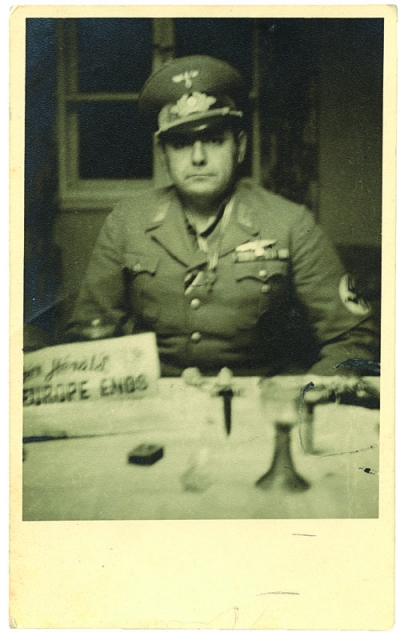
UNDERCOVER: Brickman saw the effects of Nazism first-hand. Drafted in 1943, he spent part of his military service behind enemy lines in Germany—where he donned an SS uniform and served as a spy for the OSS, the forerunner of the CIA. The agency relied on his fluency with multiple languages and dialects to lure high-level Nazis out of hiding and round them up for interrogation.
Kandel and Brickman wrote extensively on education in war and its aftermath, as well as on education in general under totalitarianism. Articles that Kandel wrote include such titles as “The Messianic Complex” (co-written with W. M. Kotschnig), “Reorienting Japanese Education,” “We Move toward Centralization,” “Education for Enduring Peace,” “Conflicts of Power in Modern Culture,” “The Vichy Government and Education in France,” “Education in an Era of Transition” (referring to educational reconstruction), “Education and Human Rights,” and “Approaches to World Peace.” Brickman’s works include such titles as “Education in the Occupied Countries,” “Education under Totalitarianism and Reconstruction,” “Communism and American Education,” “The Changing Soviet School,” and “The New Assault on Academic Freedom.”
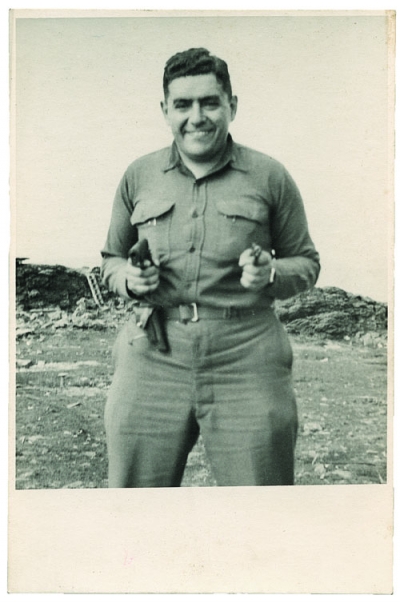
AMONG ENEMIES: Brickman, shown wearing Army fatigues and holding a pistol, once said that weight gain was one of the occupational hazards of his career as a spy. As an Orthodox Jew trying to keep kosher even among the Nazis, he was forced to fill up on potatoes.
Nazi education was one abiding interest of both men; so was Soviet education. Although Kandel and Brickman had a similar antipathy to the Soviet system, their aversion took opposite forms. Kandel refused to travel to the Soviet Union, preferring to study it from afar, whereas Brickman jumped at the chance to go and observe that country first-hand. To some extent, Kandel’s reaction stemmed from not having a command of Russian, whereas Brickman had mastered that language among the many he knew.
More than lacking a facility in Russian, Kandel was reluctant to go to the Soviet Union because of his opposition to the progressive movement, several members of which were touting the values of the Soviet system of education in the 1920s and 1930s. Progressivism emerged initially from the ideas of John Dewey, but according to both Dewey and Kandel, those ideas were distorted by some of their colleagues, especially William Kilpatrick and George Counts, at Teachers College, Columbia University. Progressive education stood for “self-realization,” “solving the problems of life,” spontaneous learning, and catering to the immediate needs of most students. It advocated physical, practical, and social activity as against an emphasis on the classics, history, the arts, and mathematics.
Progressive education, abetted by the great prominence of the Teachers College faculty who led the movement, began in the 1920s and became a national phenomenon in the 1930s, embraced by many schools throughout the country. Kandel, joined by William Bagley, also at Teachers College and equally prominent, vigorously opposed progressivism. They referred to themselves and their allies as essentialists, proponents of a traditional curriculum, with a heavy emphasis on traditional subjects in the humanities and the natural and mathematical sciences. As Kandel wrote in The Parents’ Magazine,
The battle between these two movements has echoed throughout the years, with the popularity of each side ebbing and flowing as the mood in the United States changes.
Kandel was particularly alarmed at a direction that Kilpatrick, at least initially, and Counts had taken. Kilpatrick and Counts had traveled to the Soviet Union to observe the new Russian socialist educational system. They were ecstatic to find that the new Soviet education followed a progressive path in which children worked on solving practical problems relating to agriculture and the workplace. Kilpatrick went so far as to invite a Soviet professor to lecture at Teachers College on the benefits of the Soviet educational system.
Kandel, however, observed a profound contradiction in the progressives’ adoration of the Soviet system: the progressives advocated spontaneity and self-realization in students, yet every detail in the curriculum was planned in advance by the Soviet authorities to conform to the political ideology of the state. Eventually, Kilpatrick recognized the contradiction and, like Kandel, disavowed the system of indoctrinating children and preventing them from thinking for themselves. Counts, however, was not bothered by this contradiction and continued to visit the Soviet Union, extolling the virtues of having schools that molded children for the benefit of society.
By contrast, Kandel remonstrated against the use of schools for indoctrinating children to further the aims of the state’s ideology. He often focused on extreme nationalism in schools, a topic emanating from his concerns over Nazi and Soviet education.
CONTEXTUALISM VERSUS POSITIVISM
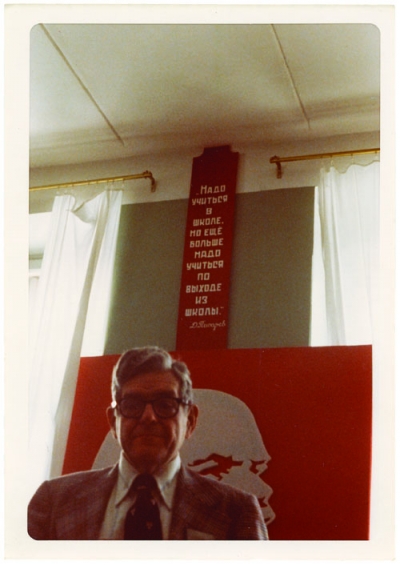
BEWARE OF MANIFESTOS: Brickman, like Kandel, paid close attention to how the Soviet Union taught its children. Unlike Kandel, Brickman actually traveled to the USSR to see for himself. Here he stands under a banner in a Soviet classroom that extols a principle used by Soviet educators, who had their admirers in the United States. Both Kandel and Brickman warned of the dangers of extreme nationalism, among other themes.
Brickman fought a different battle, especially in the 1950s and 1960s. He too was an essentialist, but his struggle was not as fierce or so much in conflict with the progressives. Rather, his concern was more with epistemology than ideology. Specifically, he was apprehensive about the growing strength of positivism in comparative education. Brickman and Kandel, who valued the use of history and philosophy and a strong grasp of social and national context in comparative studies of education, stood together on one side of the debate. They insisted that only with a deep probing of a society’s history, philosophy, and culture, requiring a command of that system’s language, can one fully understand a system of education.
By contrast, the positivists, whose strength was growing in the 1950s through the early 1970s, advocated studies that isolated and identified universal factors that influenced schooling, and that showed how school-society relationships functioned cross-culturally. Positivists such as Harold Noah, Max Eckstein, and C. Arnold Anderson de-emphasized context in favor of a “science” of comparative education, in which cross-national statistical analyses of education would rank supreme. These polarities, defined by Kandel and Brickman on one side and Noah, Eckstein, and Anderson on the other, have fashioned the underlying structure of comparative education. Just as there have been ebbs and flows in the popularity of progressivism and essentialism, so too there have been ups and downs in the embrace of positivism and the contextualism of Kandel and Brickman. Positivists require the tools of statistics; contextualists require a command of languages. Most comparativists can read and use statistics in their work, but few have the skill or inclination to establish cross-national typologies. Similarly, most comparativists have a command of one or two languages beyond their maternal tongue, but very few have a mastery of languages approaching the command possessed by Kandel and Brickman. Consequently, most comparativists work in the middle ground, using simple statistical analysis for limited purposes, an analysis of original documents in a foreign language, or both.
BUILDING ON THEIR INSIGHTS
Kandel and Brickman played a crucial role in making educators and policy makers aware of how knowledge about education in the United States and abroad is gained, and in doing so, helped set a direction for comparative education.
Too few take into account the monumental contributions of these two scholars in setting the platform for this field. What Brickman wrote of Kandel in an article titled “I. L. Kandel—International Scholar and Educator” could just as easily have applied to Brickman himself:
Kandel and Brickman were rooted in the same ethno-religious background, witnessed the ravages of Hitler’s depravity, and were bound together by common ideals of democracy and a love of comparative education.








